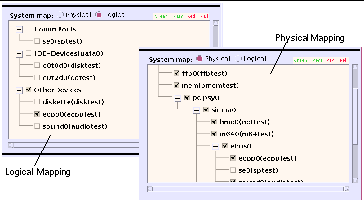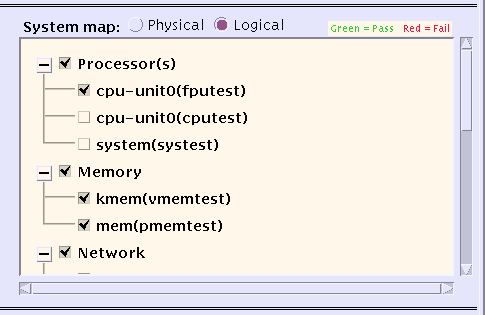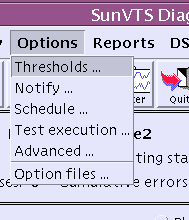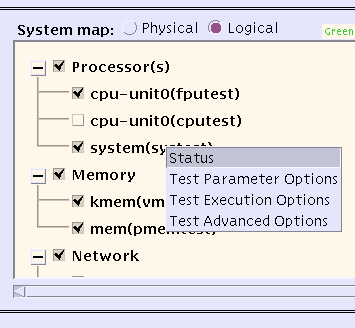The SunVTS CDE UI Main Window
When you start the SunVTS CDE user interface, the SunVTS CDE main window is displayed (Figure 4-1). SunVTS is in an idle state with all testing options set to default values.
The procedures in this chapter explain how to use the CDE main window:
Figure 4-1 SunVTS CDE Main Window

Note -
See Appendix A, SunVTS Window and Dialog Box Reference for details about each main window item.
To Configure SunVTS for a Test Session
-
Identify the current state of SunVTS in the Status panel (Figure 4-2).
Figure 4-2 CDE Status panel

The following information is displayed in the Status panel:
-
Testing status--provides the following status of SunVTS:
-
Replay--a previously recorded test session is displayed
-
Stopping--is momentarily displayed when a test session stops
-
Testing--a test session is running
-
-
System passes--displays the total number of successful system passes (a system pass is when all tests have been run once).
-
Elapsed test time--indicates the total number of hours, minutes, and seconds that elapsed during testing.
-
Last Option File--displays the name of the last option file that was accessed.
-
AC Coverage--displays the type of Auto Configuration coverage level that was selected (either confidence, comprehensive, or no_coverage when the AC feature is not in use).
-
-
Select a test mode from the Test Mode panel (Figure 4-3):
Figure 4-3 CDE Test Mode Panel

-
Connection test mode--provides a low-stress, quick testing of the availability and connectivity of selected devices. These tests are non-intrusive, meaning they will release the devices after a quick test, and they will not place a heavy load on system activity.
-
Functional test mode--provides more robust testing of your system and devices. It will use your system resources for thorough testing and it assumes that no other applications are running.
-
Auto Config mode--opens the Automatic Configuration dialog box which provides access to the Automatic Configuration feature. The Automatic Configuration feature simplifies the test session configuration by assigning a predetermined set of test options. See "Using the Automatic Configuration Feature" for instructions on using this feature.
Note -As you change test modes, the tests that are selectable in the System Map change.
-
-
Specify the System Map display mode (logical or physical):
Figure 4-4 CDE System Map (Logical View, Collapsed)

The devices that SunVTS identified as testable devices on your system are listed in the System Map (Figure 4-6). You control the way that SunVTS displays these devices by selecting one of the following:
-
Logical Mapping--organizes the devices, according to their function, into groups. For example, SCSI disk, SCSI tape, and SCSI CD-ROM drives are placed in the SCSI-Devices group. You can focus your testing on a specific device, device group, or on all of the groups on the system.
-
Physical Mapping--shows the exact location of each device on the system in relation to how the devices are connected to each other. If you are testing a single-board type system, each device is shown under the system board. Multi-board type systems show each device under the board (for example, board0, board1, and so on) to which the device is attached. For example, if you have multiple disk drives connected to different disk interfaces, each disk would be displayed under the respective interface. From Physical Mapping, you can determine the actual location of each device. When possible, the board number and controller type for the device are also displayed.
Figure 4-5 Logical and Physical Mapping Examples

How to do it:
Select the Physical or Logical button.
-
-
Expand the System Map to view selectable devices.
Figure 4-6 CDE System Map (Logical View, Expanded)

About devices in the System Map:
When SunVTS is started, most of the devices in the System Map are collapsed, meaning individual devices are grouped together and hidden from view under a device category. A "+" (plus) indicates that the device group is collapsed. A "-" (minus) indicates that the device group is expanded so you see each device for a given category.
How to do it:
Use the following methods to open the System Map:
-
Click on the "+" next to a specific group in the System Map to expand an individual group.
-
-
Select the devices that you want to test.
Figure 4-7 Devices Selected in the System Map

A checkmark next to a device in the System Map indicates that device is selected. Depending on the devices on your system, and the test mode that you select, SunVTS selects certain devices by default.
How to do it:
-
Select your devices using the buttons in the Device Selection panel:
-
None--deselects all devices
-
All--selects all devices
Note -Any device that requires your intervention before the test can run (such as loading media for tape, CD-ROM, and diskette tests), also requires that you notify SunVTS that you have performed this action by selecting the Intervention checkbox. You cannot select any intervention mode tests until you select this checkbox.
-
-
Refine the selected devices by clicking on the checkmark box next to a device or device group.
-
-
Modify the system-level test options (if desired).
SunVTS is ready to test each device once you select it. There are, however, testing options that you can modify that alter the way tests run to suit your testing needs. There are three levels where you control test options:
-
System-level options--control the testing attributes of all devices. This is the highest level, applying all your options globally. When you modify options at this level, the option settings are propagated down to the group-level and device-level options.
-
Group-level options--control the testing attributes of all the devices in the group. Settings made at this level propagate down, setting all the options in the levels in the group.
-
Device-level options--control the testing of a single, specific device. Some of these options can also be applied to the other like-devices with Apply to All pull-down menus.
The order that you apply the system-level, group-level, and device-level options is important. Start by assigning the system-level options, then assign the group-level options, and finish with the device-level options. Otherwise, if you make lower-level option settings, then higher level option settings, the higher-level settings will propagate down and undo your lower-level settings. An alternative to this approach is to use locks and overrides to protect lower level settings. See "Preserving Test Options with Locks and Overrides".
Note -System-level, group-level, and device-level options are only available when Functional Test Mode is selected. Most of these options are grayed-out and not available for Connection Mode testing.
Figure 4-8 Options from the Menu Bar

How to do it:
Access the system-level options from the Options menu in the Menu Bar (Figure 4-8).
The following dialog boxes provide system-level options that define how the entire test session runs.
-
Thresholds--provides access to test session limits such as the maximum number of system passes and the maximum test session time.
-
Notify--provides access to set up testing notification through email.
-
Schedule--provides access to auto start, single pass, and concurrency options.
-
Test Execution Options--allows you to define how a test session runs. For example, you can select stress mode which enables the most rigorous testing. You can set the Max errors value to define the maximum number of allowable errors before stopping the test (0=continue to run on infinite errors).
-
Advanced--provides overrides and locks that control which option settings (system-level, group-level, or device-level) take precedence.
Note -These dialog boxes are described in detail in Appendix A, SunVTS Window and Dialog Box Reference.
Note -To increase or decrease a numeric value in a SunVTS CDE dialog box, you can either use the up or down arrows, or type a new value in the text box and press Return. Press Apply to apply all dialog box changes.
-
-
Modify group-level and device-level options (if desired).
Figure 4-9 Test-Specific Options

About group-level and device-level options:
Group-level and device-level options are testing attributes that accompany each test and pertain to a specific device (or device group) only.
How to do it:
Access the group-level and device-level menus by placing your pointer over a device (or device-group) and right-clicking on it.
A menu appears offering access to the following dialog boxes (Figure 4-9):
-
Status--displays a list showing each test instance and a test pass and fail value for each instance.
-
Test Parameter Options--Shows device configuration information and provides the controls for defining specific test options. This menu is different for each kind of test. For example, the Test Parameter Options for the memory test (pmemtest) allow you to specify the amount of memory to test, while the network test (nettest) provides a setting to define a target host for test packets. Refer to the SunVTS 5.0 Test Reference Manual for descriptions of all the Test Parameter Options. Once you change a Test Parameter Option, apply the change to the desired level:
-
Within Instance--applies the option settings to this test instance (test instance 1 for example) with:
o Apply to Group--to all the same instances, of this device type, in the group.
o Apply to All--to all the same instances of the same device type on the system.
-
Across All Instances--applies the option settings to all test instances (for example, instance 1 and 2) with:
o Apply--for all test instances for this device.
o Apply to Group--for all test instances for the same device type in the group.
o Apply to All--for all test instances for the same device type on the system.
See "Test Parameter" for more information.
-
-
Test Execution Options--allows you to define how a test runs. For example, you can select stress mode which enables the most rigorous testing. You can set the Max errors value to define the maximum number of allowable errors before stopping the test (0=continue to run on infinite errors). The options in this menu are the same for each kind of test.
-
Test Advanced Options--Provides a setting to "lock" the option settings for an individual device so that the system level setting will not affect the option setting for this test. See "Preserving Test Options with Locks and Overrides" for more details.
-
Schedule Options (group level only)--sets the maximum number of tests you want to run at the same time in the same group.
Note -For descriptions of the options presented in these dialog boxes see, "SunVTS Dialog Boxes".
-
To Run, Monitor, and Stop a Test Session
-
Start the test session by clicking on the Start Button.
Depending on how you configured the options in the Test Execution menus, testing will continue until:
-
a test error is detected (this is the default behavior). If you enter a value for Run On Error, SunVTS continues to run until the specified number of errors is reached.
-
testing has reached the Max Passes value. The default is to run indefinite test passes. When individual test passes are complete, SunVTS continues to display the status testing for 5 seconds. If you do not select additional devices to test in the 5 second interval, SunVTS enters an idle state.
-
testing has reached the Max Time value. The default is to run indefinitely.
-
you select the Stop button.
-
-
Monitor the overall test session status by watching the Status panel.
The Status panel indicates that a test session is running by displaying testing for the Testing status. The system passes, cumulative errors, and elapsed test time will increment.
-
Monitor specific tests by watching the System Map.
-
An asterisk--displayed next to each device indicating the device that is currently under test. Depending on how you configured SunVTS (with the System Concurrency option), single or multiple devices are tested concurrently.
-
-
Check for test messages by watching the Test Message panel.
The Test Message panel displays test messages under the following circumstances:
-
When a test error occurs.
-
If you enable trace mode (from the Commands->Trace test menu bar selection) and set the trace to display in the window, all of the test system calls are displayed.
-
-
Stop the test session (if desired) by clicking the Stop button.
To Review and Reset Test Session Results
-
SunVTS provides access to four log files:
-
SunVTS test error log--contains time-stamped SunVTS test error messages. The log file pathname is /var/opt/SUNWvts/logs/sunvts.err. This file is not created until a SunVTS test failure occurs.
-
SunVTS kernel error log--contains time-stamped SunVTS kernel and SunVTS probe errors. SunVTS kernel errors are errors that relate to running SunVTS, and not to testing of devices. The log file pathname is /var/opt/SUNWvts/logs/vtsk.err. This file is not created until SunVTS reports a SunVTS kernel error.
-
SunVTS information log--contains informative messages that are generated when you start and stop SunVTS test sessions. The log file pathname is /var/opt/SUNWvts/logs/sunvts.info. This file is not created until a SunVTS test session runs.
-
Solaris system message log--is a log of all the general Solaris events logged by syslogd. The pathname of this log file is /var/adm/messages.
How to do it:
-
The Log file window is displayed.
-
Specify the log file that you want to view by selecting it from the top button in the Log file window.
The content of the selected log file is displayed in the window.
-
With the three lower buttons you can:
-
Delete the log file--the file remains displayed, but will be gone the next time you try to display it.
Note -Take the length of the log file into consideration before you print it.
-
-
-
Interpret SunVTS messages
There are many messages for each of the many tests that run under SunVTS. For this reason, it is difficult to document the implication of each message that you might see. Most messages contain all the explanatory text that is possible for each event that is encountered. Some messages are information messages (INFO, VERBOSE, WARNING) which do not represent an error, and some messages are error messages (ERROR and FATAL), indicating that the test detected a failure. This section explains generic test message information.
SunVTS information message example:
04/24/00 17:19:47 systemA SunVTS5.0: VTSID 34 disktest.VERBOSE c0t0d0: "number of blocks 3629760"
SunVTS error message example:
05/02/00 10:49:43 systemA SunVTS5.0: VTSID 8040 disktest. FATAL diskette: "Failed get_volmgr_name()" Probable_Cause(s): (1)No floppy disk in drive Recommended_Action(s): (1)Check the floppy drive
Whenever possible, the error message supplies a message type (Table 4-1), followed by the message text, one or more probable causes, and one or more recommended corrective actions.
The following table describes the types of messages you might encounter. All messages are displayed in the Message panel, and most are logged in one of the SunVTS logs (Info or Error).
Table 4-1 Message TypesMessage Type
Log file
Description
INFO
Info log
Displayed when a non-error test event occurs.
ERROR
Error and Info logs
Displayed when a test detects an error, often an indication of a problem with a specific function or feature of the device under test.
FATAL
Error and Info logs
Displayed when a test detects a severe error that might cause the test to exit; such as a failure to open a device. These errors are indicative of hardware failures.
VERBOSE
Not logged
Test progression messages that are displayed when the verbose feature is enabled.
WARNING
Info log
Displayed when something affects the test that is not an error; such as a device that is busy.
You can write scripts that watch for certain SunVTS events as they are logged in the log files, and which trigger an action when a particular message string occurs. If you plan to do this, refer to the following SunVTS message syntax and descriptions (Table 4-2).
SunVTS Message Syntax
: Table 4-2 SunVTS Message Syntax Descriptions
<timestamp> <hostname> "SunVTS<version_id>:" [VTSID <vts_msgid> <modulename>[.<submodulename>][.<instnum>][(#P)].<vts_msgtype>] [<device_pathname>:] <msg_text>
Message Item
Descriptions
<timestamp>
Represents the date in mm/dd/yy format, and the time in hh:mm:ss format, when the message was logged.
<hostname>
Name of the system under test.
SunVTS<version_id>
Displays the string SunVTS followed by the version of SunVTS, for example SunVTS5.0.
VTSID <vts_msgid>
Displays the string VTSID followed by the ID of the message.
<modulename>
Name of the module (usually the test name or vtsk) that generated the message.
<submodulename>
Name of the subtest, if applicable.
<instnum>
Number of the test instance.
(#P)
Processor ID for which the test is bound (applicable if a test is assigned to a specific processor with the processor affinity option).
<vts_msgtype>
Identifies the message with one of the following message types: ERROR, FATAL, INFO, VERBOSE, or WARNING.
<device_pathname>
Name of the device under test.
<msg_text>
The text of the message. This often includes the error, a probable cause, and a recommended action.
Note -The message syntax changed as of SunVTS 4.0. For the old message syntax information, see Appendix B, Frequently Asked Questions. In a future version of SunVTS, the old message format will no longer be supported. Update any scripts that rely on the old message format.
-
Reset the test session results (if desired).
When you are done reviewing the information in the main window, you can clear the current results by clicking on the Reset button. This resets the information in the Status panel. This does not reset your test options.
- © 2010, Oracle Corporation and/or its affiliates
